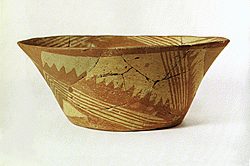 
The Middle Neolithic in Greece dates between 5800-5300 BC. This period is also called Sesklo culture, since in the settlement of Sesklo in Magnesia, all cultural achievements that characterized Thessaly during this period were recorded for the first time. Sites in the lowlands and the hills, already known from the Early Neolithic, remained inhabited during the Middle Neolithic as well, both on the shores and the hinterland of the Greek mainland and the islands, the Cyclades excluded. In architecture the construction of timber-post framed dwellings continued (Nea Makri), while for the first time houses with stone foundations were built (Sesklo) and walls from mud-bricks (unfired bricks from a mixture of clay and hay). The importance of this new technological and social event is reflected in the construction of clay house models, in which the building details are depicted with painted designs. Houses were rectangular, one-roomed or even possessed an open or closed porch (megaron-type). They were built independently of each other with just a ground floor, while there are indications that one-storey buildings were used (Sesklo). The "Tsangli type" house (three examples in the settlement of Tsangli) with two interior buttresses, that is projecting walls, on each side, and with a row of posts in the middle of the square room, is distinctive of the architecture of the Middle Neolithic. Buttresses served both to support the roof and to segregate the space for various functions, such as food preparation, storage, sleeping etc. At the end of this period the destruction of certain settlements by fire has been observed, several of which were abandoned (Sesklo) for a long period, while others were immediately re-inhabited (Tsangli-Larisa). No changes took place concerning the economy or the social composition of the farming and stock-rearing communities. The existence of painted pottery in the "citadel" of Sesklo (Seskslo A) and not in the "city" of Sesklo (Sesklo B) is the only evidence so far that differentiates the society of the Middle Neolithic in terms of economy and ideology. Burial customs were applied following the tradition of the Early Neolithic. There were continuous developments in pottery in the Early Neolithic with excellent specimens of painted pottery in red colour on a light coloured background. Solid style, flame patterned and scraped wares were the most important variations of painted pottery in Thessaly and Central Greece, while in southern Greece the Urfirnis vases predominated. Figurine art produced excellent naturalistic specimens, some of them with red painted decoration. Jewellery and seals with the meander-labyrinth as a basic motif are encountered to a lesser extent than in the Early Neolithic. |